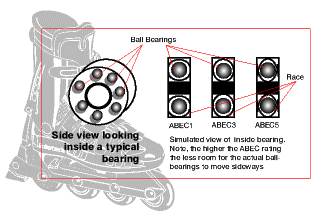| "Everthing you've always wanted to know about bearings but were afraid to ask" | ||
|
Home
|
"The ball
bearings we use in our skates are made up of several parts and pieces: The balls (generally made from steel). The cage (made from different materials
including nylon, plastic and steel, to keep the balls spaced properly around the bearing). |
Ceramic Vs. Steel Ball Bearings The first difference between steel and ceramic bearings is that steel bearings have 7 and sometimes 8 balls. Ceramics have a 9 ball setup. When a load is placed on the bearing that load is dispersed throughout the surface area and mass of the balls. When you have a 100lb load being distributed on a bearing (in a 7 ball bearing) it is distributed over the balls in the top of the arch, that's about 2- 2.5 balls, or 40-50 lbs per ball. In a 9 ball setup, there are always 3 balls at the top of the arch, or a load of 33lbs is placed on each ball. This will reduce the load on the bearing creating less friction/rolling resistance and make the bearing more durable than a standard steel bearing. Material differences. In a steel bearing, heat builds up as a result of skate generated friction. The steel ball will fall victim to heat expansion at that point. Once the balls start to expand, they effectively start to bind in the races of the bearing and begin to slow down. That is one reason lubrication is needed in steel bearings, to keep the friction/operating temperature down inside the bearing. In a ceramic bearing, the material is so resillient to heat expansion that temperatures of around 1200 degrees F can be placed on the material without much expansion. This means that you do not have any binding or slowing down beacause of heat expansion. Also, the highly polished and very hard surface of the ceramic generates only a small amount of friction so it requires less (if any) lubrication (we only reccommend light oil in order to keep the races corrosion free). Now what are the performance differences between the two? In a free spin roll time comparison test performed by our engineers on Oct 23, 2000, we compared a standard 608zz ABEC 5- 7 ball steel bearing and our China SiN Ceramic 9 Ball bearing. The results are pretty astounding. The average roll time for the steel bearing (3 trials) was 13 seconds. The average roll time for our Chinese Ceramic (3 trials) was 330 seconds. The proof is in the pudding on this one. No matter how much technical mumbo jumbo I tell people, the easiest difference is in the test results. Steven R. Terry |
|
What about ABEC ratings? When all levels of ABEC are made with the same standard of
quality, a ball-bearing in an ABEC 5 will spin faster because it has less room to move
laterally, thus all it's energy is propelled forward. The unfortunate part is that not all
bearings are made to a high standard. It is all a matter of quality. The better bearings
are made perfectly round and smooth. The races and bearings in a good skate are honed and
polished two or three times. In cheap bearings, the ball-bearings are very rough with many
imperfections. There are other factors but it becomes more complicated. Just remember that
if you purchase a skate with a good quality bearing you will roll along just fine. To
illustrate this, one of the fastest consumer level bearings on the market is the Boss
Swiss Bearing which is not even rated. Industry experts say it is probably an ABEC one or
three. Racers will often use ABEC 1 bearings in their skates (these would sell for $160
plus). |
||
|
My mate's bearings spin longer - are they better? The simple answer is "Not necessarily". Let me explain. The difference between spinning the wheel and seeing how long it takes to stop and actually using the bearings during skating is the loading on the bearings. When you are skating, there is a lot of force from all of your weight on those bearings. When you hold the skate up, the only load is the weight of 1 wheel. Testing how well the bearings perform with no load will not tell you anything about how well they will perform loaded. Try this (or at least think about it):
Which do you think will need the steeper slope? This is the one that would spin longer unloaded. Which do you think would roll better with 80kg on it? That is the one that would make a better bearing. Basically, the resistance caused by lubricant is unaffected by the load on the bearing. The resistance caused by irregularities in the bearing surface will increase with the load. As such, with no load; lubricant drag is the dominant force whereas with a large load surface quality is dominant. This is why the spin test is of no use at all in determining how well the bearings will perform when you are skating.
|
||
